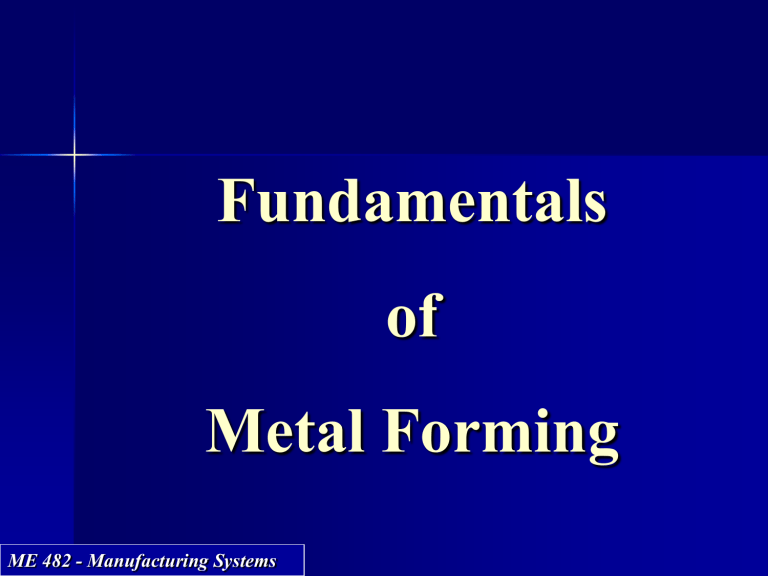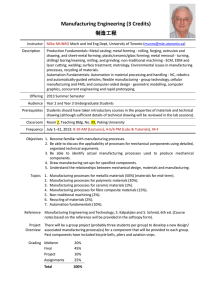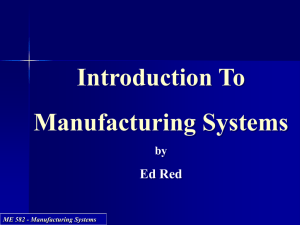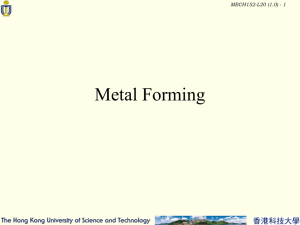Fundamentals of Metal Forming

Fundamentals of
Metal Forming
ME 482 - Manufacturing Systems
Fundamentals of Metal Forming
Bulk deformation vs Sheetmetal working
Bulk deformation Aluminum extrudate – a simple angled shape.
The die shown is more complex.
* Low surface area to volume ratios
* Operations increase surface area to volume ratios
Operations are: rolling half mile long - roll the slab into sheet steel using tremendous pressure.
forging extrusion drawing
ME 482 - Manufacturing Systems
Fundamentals of Metal Forming
Bulk deformation
• Rolling characteristics
* compressive deformation
* 2 or more rolls
* strong frictional relationship
• Extrusion characteristics
* compressive deformation
* force metal through die opening
* strong frictional relationship
* hot and cold working process
ME 482 - Manufacturing Systems
Fundamentals of Metal Forming
Sheet metalworking
Characterized by:
* large surface area to volume ratios
* little ratio change after process
* machines called presses
* parts called stampings
* tools are punch and die
Operations: bending drawing shearing
ME 482 - Manufacturing Systems
Material Behavior – Flow Stress
= K e n
Concept of flow stress , Y f
– the instantaneous stress required to deform the material
Y f
= K e n
Process force considerations:
* during compression, determine instantaneous force from Y f
* max force is often all that is required, typically at end of stroke
* force analysis may be based on average stresses and strains
Average flow stress = Y f
= K e n /(1 + n)
ME 482 - Manufacturing Systems
Fundamentals of Metal Forming
Temperature and Metal Forming
K and n depend on working temperature, characterized by
3 ranges:
Cold working
Warm working
Hot working
ME 482 - Manufacturing Systems
Fundamentals of Metal Forming
Temperature and Metal Forming –
cold working
Advantages:
* good accuracy and tolerances
* better surface finish
* strain hardening increases strength and hardness
* directional properties
* energy economy
Disadvantages:
* higher forces/power
* strain hardening limits deformation
* may need to anneal
ME 482 - Manufacturing Systems
Fundamentals of Metal Forming
Temperature and Metal Forming –
warm working
Advantages:
* above room temp., but below re-crystallization temp. (0.3 T m
* lower forces and power
)
* reduced strain hardening
* more difficult geometry
* no need for annealing
Disadvantages:
* more energy
* limited geometry
ME 482 - Manufacturing Systems
Fundamentals of Metal Forming
Temperature and Metal Forming –
hot working
Advantages:
* above re-crystallization temp. (0.5 T m
* lower forces and power
* no strain hardening
* difficult geometry
* isotropic properties
< T < 0.75 T m
)
Disadvantages:
* more energy
* poorer surface finish
* shorter tool life
ME 482 - Manufacturing Systems
Fundamentals of Metal Forming -
Strain Rate
Room temp.
Note: Strain rate a strong function of working temperature
400º C where
v h v = speed of testing head
(high values -> 1000 s -1 )
1200º C
Strain rate equation: strain rate is negligible at
Y f
= C e m room temperature!
Strain rate
C = strength constant m = strain-rate coefficient
ME 482 - Manufacturing Systems
Friction and lubrication
Friction:
* undesirable
* retards metal flow (residual stresses & defects)
* increases force and power requirements
* wears tooling
* high temperature stiction
Lubricants are usually oil-based, and when used in extreme pressure situations, sulfur,
Lubricants: chlorine and phosphorus in the lubricant may chemically react with the metal surfaces (tool, chip). The reactions form a
* reduce frictional effects
* remove heat and material
* lengthen tool life surface boundary layer that is more effective than the lubricant itself in reducing friction. Lubricants are most effective at cutting speeds < 400 ft/min.
* may react chemically with tool or work
* concerns about toxicity, flammability….(mineral oils, emulsions, oils, graphite, glass..)
ME 482 - Manufacturing Systems
Example 20.6
For a metal with K = 50,000 lb/in 2 and n = 0.27, determine the average flow stress that the metal experiences if it is subjected to a stress that is equal to its strength coefficient K.
Solution:
Y f
= K = 50,000 = 50,000 e n
Thus e = 1
Y f
= 50,000 (1) 0.27
/1.27 = 39,370 lb/in 2
ME 482 - Manufacturing Systems
What have you learned?
ME 482 - Manufacturing Systems







